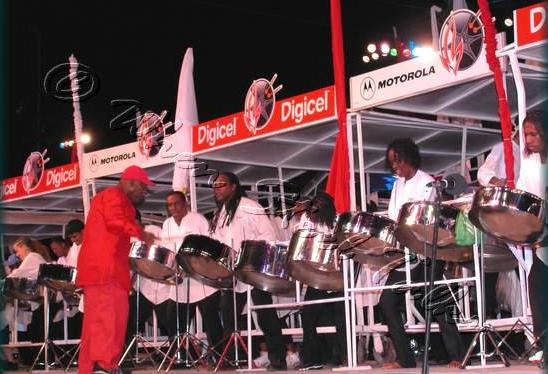 Legendary
Len
“Boogsie”
Sharpe &
Phase
II Pan
Groove
at Panorama
- “Is
this
all
there
is?”
Legendary
Len
“Boogsie”
Sharpe &
Phase
II Pan
Groove
at Panorama
- “Is
this
all
there
is?”
...if
the steelpan
was invented
in Jamaica...
Global
-
I don’t
know if
he remembers
making the
comment
or still
is of that
view, perhaps
more than
twenty years
later, but
no less
a Pan-world
figure than
“Boogsie”
Sharpe once
said to
me that
if Pan had
been invented
in Jamaica,
it would
have made
greater
progress.
The particular
reference
to Jamaica
(or anyplace
else, for
that matter)
in that
context
might precipitate
some spirited
give-and-take.
But be that
as it may,
there’s
no doubt
lots of
us have
had occasion,
over time,
to ponder
the path
Pan has
traveled,
and whether
we Trinidadians,
as its creators
and gatekeepers
of record,
have come
anywhere
close to
affording
ample opportunity
for Pan
to realize
its full
potential.
It’s impossible
for any
serious
discussion
about what
calypsonian
Cro Cro
articulated
in, “Wey
Pan Reach”
to take
place absent
such inquiry.
Indigenous
folk culture
has been
our focus
in the
Trinidad &
Tobago Folk
Arts Institute
from its
inception
in the early
‘90s, and
pan-related
matters
have necessarily
commanded
much of
our attention
during that
time. This
spring,
two of the
three forums
we presented
at Medgar
Evers College
in Brooklyn,
as part
of an ongoing
collaboration
with that
institution,
centered
on the steel
band. Inevitably,
our examination
in these
recent sessions
of
the Panorama
phenomenon
had to touch
on how much
imaginative
application
have we
brought
to bear
on this
steel pan
bonanza
that we’ve
bestowed
on the music
world.
Panorama,
whether
in its present
form or
some retrofitted
incarnation,
has obviously
become firmly
etched in
the psyche
of the international
pan community,
and figures
to be around
for quite
a while
yet, despite
legitimate
concerns
that have
been raised
about certain
aspects
of it. One
of those
frequently
voiced protestations,
relative
to Trinidad’s
Carnival
(as well
as satellite
reproductions
elsewhere),
is the extent
to which
Panorama
has come
to supplant
the street
revelry
component
of Carnival
as the steel
bands’ major
area of
concentration.
The assertion
was correctly
made by
Garvin Blake,
a panelist
at the Folk
Arts Institute’s
Panorama-themed
forum
in April,
that Carnival
revelry
has evolved
to a form
that has
literally
dispatched
the sound
of Pan music
to the sidelines,
what with
the profusion
of booming
deejay sound
systems
dominating
the spectacle.
Blake also
noted, again
correctly,
in response
to concern
about Pan
music missing
in action
on the Carnival
roadways,
that in
fact many
steel bands
do make
an appearance
on the road.
Ah, but
on the road,
how? That’s
the question.
A token
presence
featuring
a small
player contingent,
with a relatively
small following
of diehards
and with
the music
hardly projecting
beyond the
space the
unit occupies,
is tantamount
to no appearance
at all.
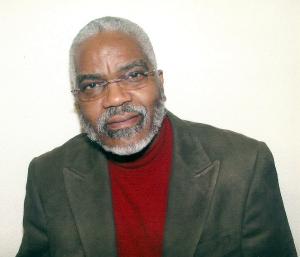
Les
Slater
- Chairman
of the
T&T
Folk
Arts
Institute
addresses
forum
Sometime
early in
the decade
of the ‘90s
when, presumably
responding
to some
sort of
lobbying
effort,
the state
[Trinidad &
Tobago]
came out
with a declaration
of the steel
pan as the
national
instrument
of Trinidad
and Tobago,
this was
welcomed
by many
as a ground-breaking
development
for Pan
in its birthplace.
My own response
was rather
muted, typically
opting to
be cautious
about all
the hoopla
since, based
on the narrative
to that
point, there
was every
likelihood
the fanfare
surrounding
this “national
instrument”
proclamation
would be
as far as
the designated
stakeholders
would get,
with respect
to any serious,
informed
approach
to examining
where Pan
was and
where it
ought to
be – something
that had
all along
been conspicuously
lacking.
Those stakeholders,
sad to say,
proceeded
exactly
as one feared.
It is incomprehensible
that almost
70 years
after the
Steel Pan
made its
first steps
toward recognition
as a credible
addition
to the family
of instruments,
and despite
so many
outstanding
examples
of its music-making
possibilities
on a global
scale, Pan
at its core
continues
to be seen
in very
confining
terms. So
that, to
return to
the Trinidad
Carnival
setting,
once the
unwieldy
caravan
of racks
being pushed
along the
streets
as an “orchestra”
became the
dinosaur
it should
have been
early recognized
to be, the
movers and
shakers
of steel
pan were
content
to defer
to whatever
else got
ushered
into that
position
of street
parade dominance.
Movement
leaders,
to their
discredit,
failed to
see in the
disappearing
pan-pushing
routine,
a cue to
get creative
about ensuring
that this
powerful
invention
of ours
retained
a place
in the country’s
grandest
music showcase.
Believing
the Panorama
competition,
in the circumstances,
to be the
only option
for a Carnival
presence
for Pan
was, again,
indicative
of the blinders
that have
bedeviled
this art
form’s forward
movement,
more so
on its home
turf.
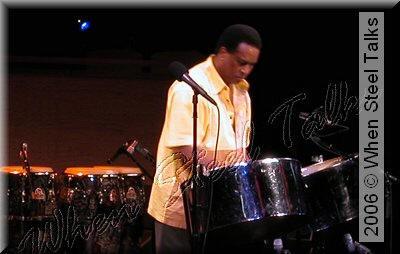
Robert
Greenidge
performing
at Lincoln
Center
Had there
been some
semblance
of an understanding
in strategic
places,
of what
a “national
instrument”
designation
should entail,
that big
noise from
the state
almost twenty
years ago
would have
made for
a new level
of respect
for the
Pan, for
the kind
of popular
culture
identity
it clearly
warrants.
A change,
if you will,
that would
have made
obsolete
the comment
back in
the 1980s
of one pretty
well credentialed
observer:
“Pan is
Pan, real
music is
real music,
and never
the twain
shall meet.”
It was a
cogent reaction
to the partitioning,
imposed
by others
and insouciantly
accommodated
by the Pan
community,
that has
confirmed
the steel
pan in a
secondary
role, never
to be aligned
or integrated
with first-tier
music making.
The “national
instrument”
holding
down a slot
in Machel’s
band, or
Kes or Roy
Cape? Not
a chance.
In essence
the instrument’s
birthplace
has said:
“This isn’t
Jimmy Buffett’s
band, where
Robert Greenidge
does his
thing; or
Andy Narell’s
well documented
exploits;
or
Rudy Smith
leading
a jazz quartet
in Europe.”
In its birthplace,
the “national
instrument”
has been
assigned,
and regrettably
has tacitly
accepted,
diminished
status on
that order.
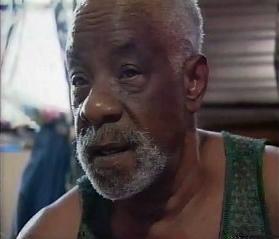 Pan
visionary
Bertie
Marshall
Pan
visionary
Bertie
Marshall
So, yes,
Carnival’s
street revelry
has evolved
in form,
as has its
accompanying
music. And
maybe the
sound of
Pan was
destined
to be left
behind by
such evolution.
But with
pan people
never having
considered
being players
in the mix,
we’ll never
know, will
we, if there
was no way
the Pan
could make
a valid
contribution.
Look, there’s
been so
much room
for exploration
between
these two
extremes:
old fogies
still rhapsodizing
about pushing
Pan as seventh
heaven and
the ear-splitting
noise latterly
presented
as the new
normal of
Carnival
revelry.
Visionary
that he
was and
is,
Bertie Marshall
saw the
need for
the pan
to make
a seismic
shift way
back in
the ‘60s,
when he
introduced
the concept
of amplification
with the
Highlanders
band. Again,
whether
bands going
the route
of electronic
enhancement
offered
the most
viable way
forward,
we’ll never
know, Marshall’s
ingenious
early moves
toward a
fix having
been summarily
dissed by
the brethren.
(click
to watch
film on
Bertie Marshall
by Dalton
Narine)
 Steelpan
logo
on Trinidad
and
Tobago’s
former
national
airline
BWIA
- no
longer
so
Steelpan
logo
on Trinidad
and
Tobago’s
former
national
airline
BWIA
- no
longer
so
This nirvana
that the
brethren
seemingly
found in
Panorama
simply underscores
what Brooklyn
College
Professor
of Performance
Studies
Dale Byam
has called
the absence
of a “national
imagination”
in Trinidad
and Tobago
to encourage
inspired
engagement
of certain
constituent
elements
of the cultural
mosaic.
Foremost
of these,
I would
venture,
is the steel
pan. Panorama
is fine,
as far as
it goes.
To be sure,
it has become
a magnet
for a cadre
of young
people,
local and
foreign,
who evidently
have taken
a fancy
to its strut-your-stuff
appeal.
And it has
provided
scope for
a younger
generation
of Pan arrangers
to show
off their
skills.
And there
can be no
argument
with any
of that.
But it seems
the horizons
are quite
a bit more
limited
than they
need to
be, when
the only
game in
town is
the niche
of a niche
market that
is Panorama.
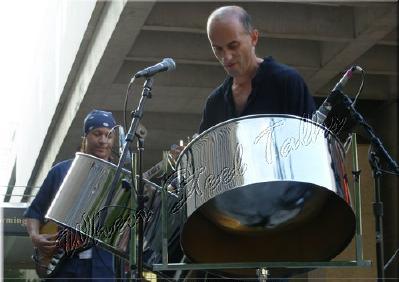
Andy
Narell
performing
at Lincoln
Center
I mean,
could we
really be
comfortable
with a pigeonholing
of the “national
instrument”
in which
a single
billboard
event for
the year
is accepted
without
murmur as
the limit
of folks’
expectations?
Is there
such indifference
that a sweetened
pot of Panorama
prize money
makes everything
right that’s
wrong with
that picture?
Does no
one care
about a
widespread
understanding
that a steel
pan’s “proper”
(and only)
assigned
place is
in a steel
band? Do
the experiences
of Greenidge,
Narell,
et al have
no impact
on the country’s
musicians,
who continue
to regard
the steel
pan as a
totally
separate
and different
animal,
apparently
undeserving
of sharing
their space?
And is this
not bothersome
to the wider
society,
more so
those positioned
to act and
advocate
for an attitudinal
overhaul?
Has it never
occurred
to anyone,
for instance,
that the
“national
instrument”
ought be
showcased
alongside
Trinidadian
musicians
wherever
around the
world they
perform?
The unenlightened
view that
the status
quo, as
it relates
to pan,
is fine
has been
sufficient
to dim any
points of
light that
have attempted
to shine
through
over the
years. Bertie
Marshall
certainly
has been
one of them.
Honorable
mention
should be
made also
of a little
known experiment
by the noted
Trinidadian
musician
Cyril Diaz
who, in
the Pan-round-the-neck
days in
1957, had
a section
of Pan players
from Bertie
Marshall’s
Elite Steel
Band join
the Diaz
orchestra
on the road
to supply
music for
a group
of Port
of Spain
masqueraders.
Here we
are, more
than 50
years later,
and the
record remains
abysmal,
as far as
doing right
by Pan.
What’s frustrating
is that
we did the
difficult
part with
awe-inspiring
ingenuity:
against
incredible
odds, we
fashioned
this fantastic
new instrument.
The rest
should have
more easily
fallen into
place. There
could be
no excuse
for coming
up short
on according
the Steel
Pan the
respect
it has earned.
Les Slater
is the
chairman
of the T&T
Folk Arts
Institute
and former
Highlanders
Steel Orchestra
arranger.
Contact
Les Slater:
email:
slatertalentmart@yahoo.com
click for
more on
Les Slater












